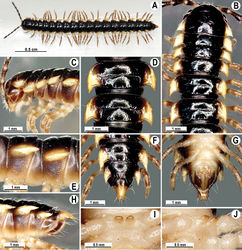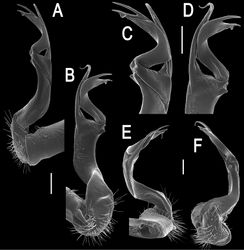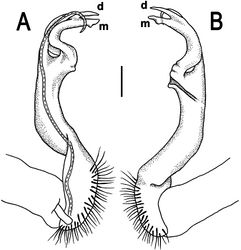Orthomorpha paviei
| Notice: | This page is derived from the original publication listed below, whose author(s) should always be credited. Further contributors may edit and improve the content of this page and, consequently, need to be credited as well (see page history). Any assessment of factual correctness requires a careful review of the original article as well as of subsequent contributions.
If you are uncertain whether your planned contribution is correct or not, we suggest that you use the associated discussion page instead of editing the page directly. This page should be cited as follows (rationale):
Citation formats to copy and paste
BibTeX: @article{Likhitrakarn2014ZooKeys374, RIS/ Endnote: TY - JOUR Wikipedia/ Citizendium: <ref name="Likhitrakarn2014ZooKeys374">{{Citation See also the citation download page at the journal. |
Ordo: Polydesmida
Familia: Paradoxosomatidae
Genus: Orthomorpha
Name
Orthomorpha paviei Brölemann, 1896 – Wikispecies link – Pensoft Profile
- Orthomorpha Paviei Brölemann, 1896: 1 (D).
- Orthomorpha Paviei – Brölemann 1904[1]: 8 (D).
- Prionopeltis Paviei ? – Attems 1914[2]: 204 (M).
- Pratinus paviei – Attems 1937[3]: 122 (M).
- Orthomorpha paviei – Jeekel 1963[4]: 265 (M); 1964[5]: 359 (M); 1968[6]: 56 (M); Golovatch 1998[7]: 42 (D); Enghoff et al. 2004[8]: 34 (M); Enghoff 2005[9]: 97 (M); Likhitrakarn et al. 2011[10]: 52 (D).
Material examined:
1 ♂ (CUMZ), Laos, Champasak Province, Khong District, Khone Phapheng Waterfall, 82 m a.s.l., 13°57'47"N, 105°59'17"E, 23.07.2013, leg. W. Siriwut.
Diagnosis
According to the key in Likhitrakarn et al. (2011)[10], this species is especially similar to Orthomorpha coarctata (De Saussure, 1860), but differs in the paraterga more strongly developed, in having two, fully separated, sternal cones between ♂ coxae 4, and a nearly trifid gonopod tip with two clearly larger prongs being deeply split with a third, very small denticle lying ventrally at about midway of the second, slightly stronger prong.
Redescription
Length 25 mm (♂), width of midbody pro- and metazona 2.06 and 3.23 mm, respectively.
Coloration of live animals blackish (Fig. 1A), paraterga and epiproct contrasting dark yellow, head and antennae brownish, legs pale brownish; coloration in alcohol, after three months of preservation, faded to black-brown (Fig. 1B–H), paraterga and epiproct pale whitish yellow or pale brown, legs whitish to pale brown distally.
Clypeolabral region densely setose, vertigial region with a few setae only; epicranial suture distinct. Antennae long (Fig. 1A), reaching posterior end of body segment 4 when stretched dorsally. In width, head < segment 3 = 4 < collum < segment 2 < 5–17, gently and gradually tapering thereafter. Collum with three transverse rows of setae: 4+4 in anterior, 3+3 in intermediate, and 1+1 in posterior row; a very faint incision laterally near midway; caudal corner of paraterga pointed, dentiform, slightly upturned, but not drawn behind rear margin (Fig. 1B, C). Tegument smooth and shining, prozona finely shagreened, metaterga smooth and delicately rugulose, leathery; surface below paraterga finely microgranulate. Postcollum metaterga with two transverse rows of setae traceable at least as insertion points when setae broken off: 2+2 in anterior (pre-sulcus), 3–4+3–4 in posterior (post-sulcus) row. Tergal setae long, strong, slender, about 1/3 of metatergal length. Axial line visible only on metaterga, slightly better developed on their posterior halves. Paraterga very strongly developed (Fig. 1B–H), mostly slightly upturned, all lying faintly below dorsum, set at about upper 1/3 of midbody height, subhorizontal, caudal corner almost or fully pointed, increasingly well spiniform and produced behind rear tergal margin until segment 18; paraterga very thin in lateral view, blunt blades, modestly enlarged in pore-bearing segments, thinner in poreless ones. Calluses on paraterga 2–4 delimited by a sulcus only dorsally, on following paraterga both dorsally and ventrally. Paraterga 2 broad, anterior edge angular, lateral edge with one larger and two smaller, but evident incisions in anterior 1/3; posterior edge well concave (Fig. 1B, D, F). Anterior edges of paraterga 3–9 clearly convex, of paraterga 10–18 nearly straight and slightly bordered. Lateral edge of paraterga with two slight, but evident incisions, one in anterior 1/3, the other in posterior 1/3. Posterior edge of paraterga clearly concave, especially well so in segments 16–19 (Fig. 1F–H). Ozopores evident, lateral, lying in an ovoid groove at about 1/4 of metatergite’s length in front of caudal corner. Transverse sulcus usually distinct (Fig. 1C, E, H), complete on metaterga 5–19, incomplete and nearly wanting on 19th, shallow, nearly reaching bases of paraterga, rather faintly beaded at bottom. Stricture between pro- and metazona wide, clearly beaded at bottom down to base of paraterga (Fig. 1B, D, F). Pleurosternal carinae complete crests with a sharp caudal tooth in segment 2, a very sharp, caudal tooth in segments 3 and 4, a small, mostly sharp tooth in segments 5–9 (Fig. 1C, E). Epiproct (Fig. 1F, G) conical, flattened dorsoventrally, with two evident apical papillae; tip subtruncate; pre-apical papillae small, but visible, lying rather close to tip. Hypoproct roundly subtriangular, setiferous knobs at caudal edge evident and well-separated.
Sterna sparsely setose, without modifications; two rather large, fully separated, sternal cones between ♂ coxae 4 (Fig. 1I, J). A paramedian pair of evident tubercles in front of gonopod aperture. Legs moderately long and slender, midbody ones ca 1.1–1.2 times as long as body height, prefemora without modifications, ♂ tarsal brushes present until legs of segment 8.
Gonopods (Figs 2, 3) with slender and long coxae, the latter with several setae distoventrally. Femorite about 3 times as long as prefemoral (= strongly setose) part. Femorite slender, slightly curved, postfemoral portion demarcated by an oblique lateral sulcus; tip of solenophore indistinctly trifid, both dorsal (d) and middle (m) prongs being sharp and deeply split, middle prong slightly stronger, supplied with a minute, but evident subterminal knob/lobule ventrally at about midway; solenomere long and flagelliform.
Remarks
The new specimen agrees nearly fully with the most detailed and beautifully illustrated descriptions of the species given by Brölemann (1896[11], 1904[1]), but the holotype is larger: body length 40 mm versus 25 mm, width of midbody metazona 4.25 mm versus 3.23 mm. In addition, a transverse sulcus is visible in segments 4–18 in the holotype versus segments 5–19 in the fresh ♂. Originally described from an unspecified locality in Thailand (Brölemann 1896[11], 1904[1]), Orthomorpha paviei is thus new to the fauna of Laos.
In having both apical prongs of the gonopods rather deeply split, this species is somewhat intermediate between the genera Antheromorpha Jeekel, 1968 and Orthomorpha Bollman, 1893 (Likhitrakarn et al. 2011[10]).
The above detailed redescription is given not only to better outline the quite modest variations found in Orthomorpha paviei, but also to serve as a pattern for further, more condensed descriptions or descriptive notes below.
Taxon Treatment
- Likhitrakarn, N; Golovatch, S; Panha, S; 2014: The millipede genus Orthomorpha Bollman, 1893 in Laos (Diplopoda, Polydesmida, Paradoxosomatidae), with descriptions of new species ZooKeys, 374: 1-22. doi
Other References
- ↑ 1.0 1.1 1.2 Brölemann H (1904) Myriapodes recueillis par M. A. Pavie en Indo-Chine. In: Pavie A (Ed) Mission Pavie Indo-Chine 1879:1895. A. Etudes diverses. III. Recherches sur l’histoire naturelle de l’Indo-Chine Orientale, 296-308.
- ↑ Attems C (1914) Die indo-australischen Myriopoden. Archiv für Naturgeschichte 80A: 1–398.
- ↑ Attems C (1937) Myriapoda 3. Polydesmoidea I. Fam. Strongylosomidae. Das Tierreich 68: i–xxii, 1–300.
- ↑ Jeekel C (1963) Paradoxosomatidae from Borneo (Diplopoda, Polydesmida). Tijdschrift voor Entomologie 106: 205-283.
- ↑ Jeekel C (1964) A new species of Orthomorpha Bollman from Thailand observed in migration, with taxonomic notes on the genus (Diplopoda). Tijdschrift voor Entomologie 107: 355-364.
- ↑ Jeekel C (1968) On the classification and geographical distribution of the family Paradoxosomatidae (Diplopoda, Polydesmida). Academisch Proefschrift (PhD Thesis, privately published), Rotterdam, 162 pp.
- ↑ Golovatch S (1998) On several new or poorly-known Oriental Paradoxosomatidae (Diplopoda Polydesmida), VI. Arthropoda Selecta 6(3–4): 35–46 [for 1997].
- ↑ Enghoff H, Golovatch S, Nguyen Duc A (2004) A review of the millipede fauna of Vietnam (Diplopoda). Arthropoda Selecta 13(1–2): 29-43.
- ↑ Enghoff H (2005) The millipedes of Thailand (Diplopoda). Steenstrupia 29(1): 87-103.
- ↑ 10.0 10.1 10.2 Likhitrakarn N, Golovatch S, Panha S (2011) Revision of the Southeast Asian millipede genus Orthomorpha Bollman, 1893, with the proposal of a new genus (Diplopoda, Polydesmida, Paradoxosomatidae). ZooKeys 131: 1-161. doi: 10.3897/zookeys.131.1921
- ↑ 11.0 11.1 Brölemann H (1896) Myriapodes recueillis en Indo-Chine par M. Pavie et offerts au Muséum d’Histoire naturelle de Paris. Bulletin du Muséum d’Histoire naturelle (7): 332–333.
Images
|


